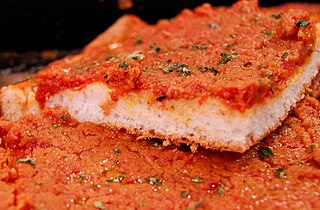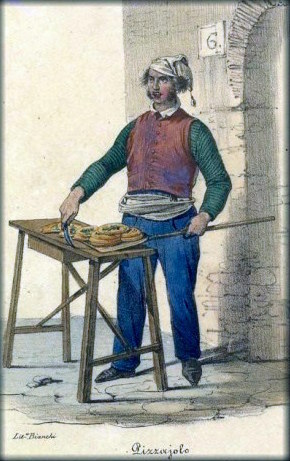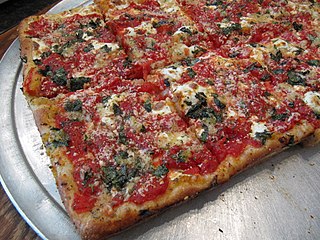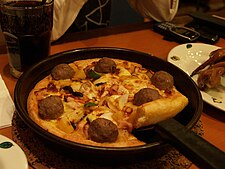
The cuisine of the American Midwest draws its culinary roots most significantly from the cuisines of Central, Northern and Eastern Europe, and Indigenous cuisine of the Americas, and is influenced by regionally and locally grown foodstuffs and cultural diversity.

Pizza is a dish of Italian origin consisting of a usually round, flat base of leavened wheat-based dough topped with tomato, cheese, and often various other ingredients, which is then baked at a high temperature, traditionally in a wood-fired oven.

Chicago-style pizza is pizza prepared according to several styles developed in Chicago. It can refer to both the well-known deep-dish or stuffed pizzas and the lesser-known thin-crust tavern-style pizzas more popular with locals. The pan in which deep-dish pizza is baked gives the pizza its characteristically high edge, which provides ample space for large amounts of cheese and a chunky tomato sauce. Chicago-style deep-dish pizza may be prepared in the deep-dish style and as a stuffed pizza. Chicago-style thin-crust pizza dough is rolled for a thinner crispier crust than other thin-crust styles. The thin-crust pizza is cut in squares instead of slices, and is also referred to as a "tavern-style" pizza.

Stuffed crust pizza is pizza with cheese or other ingredients added into the outer edge of the crust. The stuffed crust pizza was popularized by Pizza Hut, which debuted this style of pizza in 1995.

New York–style pizza is a pizza made with a characteristically large hand-tossed thin crust, often sold in wide slices to go. The crust is thick and crisp only along its edge, yet soft, thin, and pliable enough beneath its toppings to be folded in half to eat. Traditional toppings are simply tomato sauce and shredded mozzarella cheese. This was a popular meal amongst poor Italians due to the ratio of product from the limited produce.
In the cuisine of the United States, Greek pizza is a style of pizza crust and preparation where the pizza is proofed and cooked in a metal pan rather than stretched to order and baked on the floor of the pizza oven. A shallow pan is used, unlike the deep pans used in Sicilian, Chicago, or Detroit-styled pizzas. Its crust is typically spongy, airy, and light, like focaccia but not as thick. The crust is also rather oily, due to the coating of oil applied to the pan during preparation.

Sicilian pizza is a pizza prepared in a manner that originated in Sicily, Italy. Sicilian pizza is also known as sfincione or focaccia with toppings. This type of pizza became a popular dish in western Sicily by the mid-19th century and was the type of pizza usually consumed in Sicily until the 1860s. It eventually reached North America in a slightly altered form, with thicker crust and a rectangular shape.

The history of pizza begins in antiquity, as various ancient cultures produced flatbreads with several toppings.

Detroit-style pizza is a rectangular pan pizza with a thick, crisp, chewy crust. It is traditionally topped to the edges with mozzarella or Wisconsin brick cheese, which caramelizes against the high-sided heavyweight rectangular pan. Detroit-style pizza was originally baked in rectangular steel trays designed for use as automotive drip pans or to hold small industrial parts in factories. It was developed during the mid-20th century in Detroit, Michigan, before spreading to other parts of the United States in the 2010s. It is one of Detroit's iconic local foods.

Uruguayan cuisine is a fusion of cuisines from several European countries, especially of Mediterranean foods from Spain, Italy, Portugal and France. Other influences on the cuisine resulted from immigration from countries such as Germany and Scotland. Uruguayan gastronomy is a result of immigration, rather than local Amerindian cuisine, because of late-19th and early 20th century immigration waves of, mostly, Italians. Spanish influences are abundant: desserts like churros, flan, ensaimadas yoo (Catalan sweet bread), and alfajores were all brought from Spain. There are also all kinds of stews known as guisos or estofados, arroces, and fabada. All of the guisos and traditional pucheros (stews) are also of Spanish origin. Uruguayan preparations of fish, such as dried salt cod (bacalao), calamari, and octopus, originate from the Basque and Galician regions, and also Portugal. Due to its strong Italian tradition, all of the famous Italian pasta dishes are present in Uruguay including ravioli, lasagne, tortellini, fettuccine, and the traditional gnocchi. Although the pasta can be served with many sauces, there is one special sauce that was created by Uruguayans. Caruso sauce is a pasta sauce made from double cream, meat, onions, ham and mushrooms. It is very popular with sorrentinos and agnolotti. Additionally, there is Germanic influence in Uruguayan cuisine as well, particularly in sweet dishes. The pastries known as bizcochos are Germanic in origin: croissants, known as medialunas, are the most popular of these, and can be found in two varieties: butter- and lard-based. Also German in origin are the Berlinese known as bolas de fraile, and the rolls called piononos. The facturas were re-christened with local names given the difficult German phonology, and usually Uruguayanized by the addition of a dulce de leche filling. Even dishes like chucrut (sauerkraut) have also made it into mainstream Uruguayan dishes.

Lou Malnati's Pizzeria is an American Chicago-style pizza restaurant chain headquartered in Northbrook, Illinois. It was founded by the son of Rudy Malnati, who was instrumental in developing the recipe for Chicago-style pizza, and it has become one of the Chicago area's best-known local lines of pizza restaurants. Lou Malnati's operates a division of its company called Lou Malnati's Presents Tastes of Chicago, a partnership with Portillo's Restaurants and Eli's Cheesecake, which ships Chicago-style cuisine nationally.

Neapolitan cuisine has ancient historical roots that date back to the Greco-Roman period, which was enriched over the centuries by the influence of the different cultures that controlled Naples and its kingdoms, such as that of Aragon and France.

The cuisine of Michigan is part of the broader regional cuisine of the Midwestern United States. It is reflective of the diverse food history of settlement and immigration in the state, and draws its culinary roots most significantly from the cuisines of Central, Northern and Eastern Europe, and Native North America.

Pizza arrived in the United States in the early 20th century along with waves of Italian immigrants who settled primarily in the larger cities of the Northeast, such as New York, Philadelphia, Boston and Baltimore. After American soldiers stationed in Italy returned from World War II, pizza and pizzerias rapidly grew in popularity.

Quad City–style pizza is a variety of pizza originating in the Quad Cities region of the states of Illinois and Iowa in the United States.

Grandma pizza is a distinct thin, rectangular style of pizza attributed to Long Island, New York. Typically topped with cheese and tomato sauce, it is reminiscent of pizzas baked at home by Italian housewives who lacked a pizza oven. The pizza is often compared to Sicilian pizza.
The presence of pizza restaurant chains has contributed to a significant increase in pizza consumption in Mainland China and Hong Kong. This also had an effect of introducing cheese as a culinary ingredient and everyday food in China, which was relatively uncommon in Chinese cuisine prior to the emergence of pizza chains. Pizza Hut opened its first store in China in 1990, and several pizza restaurant chains exist in China today.

Trenton tomato pie or New Jersey tomato pie is a type of circular, thin-crust Italian tomato pie created in Trenton, New Jersey, United States, around the early 20th century in which cheese and other toppings are added on first, then the sauce.



















